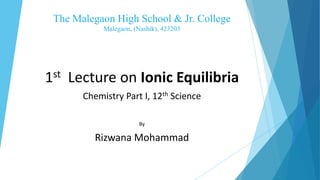
1st Lecture on Ionic Equilibria | Chemistry Part I | 12th Std
- 1. The Malegaon High School & Jr. College Malegaon, (Nashik), 423203 1st Lecture on Ionic Equilibria Chemistry Part I, 12th Science By Rizwana Mohammad
- 2. Ionic Equilibria The equilibrium between ions and unionized molecules in solution is called ionic equilibrium. Electrolyte: An electrolyte is a substance that produces an electrically conducting solution when dissolved in a polar solvent. Type of electrolyte: Electrolytes are classified into strong and weak electrolytes. Strong electrolyte: The electrolytes ionizing completely or almost completely are strong electrolytes. e.g. Strong acid, strong bases and Salts. Weak electrolyte: The electrolytes which dissociate to a smaller extent in aqueous solution are weak electrolytes. e.g. Weak acid, weak bases.
- 3. Dissociation: The spontaneous splitting of an electrolyte into positive and negative ions in aqueous medium is called Dissociation. Degree of dissociation: It is defined as, a fraction of total number of moles of the electrolyte that dissociates into its ions when the equilibrium is attained. 𝛼 = 𝑛𝑢𝑚𝑏𝑒𝑟 𝑜𝑓 𝑚𝑜𝑙𝑒𝑠 dissociated 𝑡𝑜𝑡𝑎𝑙 𝑛𝑢𝑚𝑏𝑒𝑟 𝑜𝑓 𝑚𝑜𝑙𝑒𝑠 Percent dissociation = 𝛼 × 100
- 4. Acids and Bases: Arrhenius theory of acids and bases: Acid: Acid a Substance which contain hydrogen and gives rise to H ions in aqueous solution. e.g. HCl(aq) 𝑤𝑎𝑡𝑒𝑟 H(aq) + Cl(aq) CH3COOH(aq) ⇌ CH3COO(aq) + H(aq) Base: Base is a substance that contains OH group and produces hydroxide ions (OH ) in aqueous solution. e.g. NaOH(aq) Na(aq) + OH(aq) NH4OH(aq) ⇌ NH4(aq) + OH(aq)
- 5. Bronsted-Lowry Theory: This theory is also known as proton transfer theory. Acid: Acid is a substance that donates a proton (H ) to another substance. Base: Base is a substance that accepts a proton (H ) from another substance. e.g. HCl + NH3 ⇌ NH4 + Cl acid 1 base 2 acid 2 base 1 A pair of an acid and a base differing by a proton is said to be a conjugate acid-base pair. HCl(aq) + H2O(l) ⇌ H3O(aq) +Cl(aq) acid 1 base 2 acid 2 base 1 Conjugate acid base pair 1 Conjugate acid base pair 2
- 6. Lewis theory: Acid: Any Species that accepts a share in an electron pair is called Lewis acid. Base: Any species that donates a share in an electron pair is called Lewis base. e.g. H N H H:+H + H H N HH H N H H:+B F F F H H N HB F F F acid base acid base H
- 7. Amphoteric nature of water: Water has ability to act as an acid as well as a base. Such behaviour is known as amphoteric nature of water. e.g. H2O(l) + NH3(aq) ⇌ OH(aq) + NH4(aq) acid H2O(l) + HCl(aq) ⇌H3O(aq) + Cl(aq) base
- 8. Ionization of acids and bases: Acids and bases are classified as strong acids and strong bases, weak acids and weak bases of their extent of dissociation. Strong acids and bases are almost completely dissociated in water. e.g. HCl(aq) H(aq) + Cl(aq) NaOH(aq) Na(aq) + OH(aq) Weak acids and bases are partially dissociated in water. e.g. CH3COOH(aq) ⇌ CH3COO(aq) + H(aq) NH4OH(aq) ⇌ NH4(aq) + OH(aq)
- 9. Dissociation constant of weak acids and weak bases: The dissociation of a weak acid HA in water is expressed as HA(aq) ⇌ H(aq) + A(aq) The equilibrium constant called acid dissociation constant for this equilibrium is: 𝐾 𝑎 = 𝐻 [𝐴 ] [𝐻𝐴] Similarly the dissociation of weak base BOH in water is represented as: BOH(aq) ⇌ B(aq) + OH(aq) Base dissociation constant is 𝐾 𝑏 = 𝐵 [𝑂𝐻 ] [𝐵𝑂𝐻] Thus, the dissociation constant of a weak acid or a weak base is defined as “the equilibrium constant for dissociation equilibrium of weak acid or weak base respectively.”
- 10. Ostwald’s dilute law: Arrhenius concept of acids and bases was expressed quantitatively by F.W. Ostwald in the form of the dilution Law. a- Weak Acid: Consider an equilibrium of weak acid HA, HA(aq) ⇌ H(aq) + A(aq) The acid dissociation constant is given by 𝐾 𝑎 = [𝐻 ][𝐴 ] [𝐻𝐴] …1 HA(aq) ⇌ H(aq) + A(aq) Initially 1 0 0 Amount present at 𝑒𝑞 𝑚 𝑚𝑜𝑙 1 − 𝛼 α α Concentration at eqm mol dm-3 1 − α 𝑉 α 𝑉 α 𝑉
- 11. Substituting the values in equation 1 𝐾 𝑎 = α 𝑉 α 𝑉 (1−α 𝑉) = α2 1−α 𝑉 …2 If C is the initial concentration of an acid in mol dm-3 and V is the volume in dm3 mol-1, then 𝐶 = 1 𝑉 Therefore 𝐾 𝑎 = α2 𝐶 1−α …3 For a weak acid HA, α is very small, 1 − 𝛼 ≅ 1 therefore 𝐾 𝑎 = α2 𝑉 and 𝐾 𝑎 = α2 𝐶 α = 𝐾 𝑎 𝑉 and α = 𝐾 𝑎 𝐶 …4 Equation 4 implies that the degree of dissociation of a weak acid is inversely proportional to the square root of its concentration or directly proportional to the square root of volume of the solution containing 1 mole of weak acid.
- 12. b- Weak base: Consider 1 mole of weak base BOH dissolved in V dm3 of solution. The base dissociates partially as BOH(aq) ⇌ B(aq) + OH(aq) The base dissociation constant is 𝐾 𝑏 = 𝐵 [𝑂𝐻 ] [𝐵𝑂𝐻] …1 BOH(aq) ⇌ B(aq) + OH(aq) Initially 1 0 0 Amount present at equilibrium 1 − 𝛼 α α Concentration at eqm 1 − α 𝑉 α 𝑉 α 𝑉
- 13. Substituting in eqn …1 𝐾 𝑏 = α 𝑉 (α 𝑉) (1−α 𝑉) 𝐾 𝑏 = α2 𝐶 1−α α = 𝐾 𝑏 𝑉, α = 𝐾 𝑏 𝐶 The degree of dissociation of a weak base is inversely proportional to square root of its concentration and is directly proportional to the square root of volume of the solution containing 1 mole of weak base.
